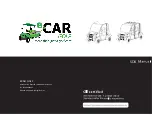
The safety committee should include all these items and such others, as the committee
feels necessary or appropriate.
Pre-Operation Checklist
Your SoloRider has been thoroughly inspected and adjusted at the factory. However,
upon arrival of your new SoloRider (s), you should become familiar with its controls and
operation, and carefully inspect each vehicle to be satisfied that it is in proper working
condition before accepting delivery.
Use the following checklist as a guide to inspect your new vehicle. This same checklist
should also be used in conjunction with the Periodic Service Schedule. Only your
SoloRider distributor/dealer or a trained technician should correct any problems.
•
General: All the parts should be in place and properly installed. Be sure that all nuts,
bolts, and screws are tight.
•
Warning Decals: Check to ensure that all warning and operation decals are in place.
•
Tires: Check for proper tire pressure. (See Vehicle Capacities).
•
Batteries: Check electrolyte to ensure that it is at its proper level (figure 6). Check
battery posts. Wires should be tight and free of corrosion. Charge batteries fully
before first use of vehicle.
Performance Inspection
After you have familiarized yourself with the vehicle’s controls and have read and
understood the driving instructions, take the vehicle for a test drive. Use the following
checklist as a guide to inspect your new vehicle. Only your SoloRider distributor/dealer
or a trained technician should correct any problems.
ALL VEHICLES:
Brakes
: Be sure the brakes function properly. When brake levers are fully depressed
under moderate pressure, each lever should not go more than halfway to the handgrip,
and vehicle should come to a smooth, straight stop within 14 feet (427 cm). If a lever
goes more than halfway to the handgrip or it the vehicle swerves or fails to stop within 14
feet (427 cm), have the brake system checked and adjusted as required. Brake
adjustment must be maintained so that the brake lever cannot be depressed to the
handgrip under any circumstance.
Park Brake
: The park brake should lock and hold the vehicle stationary (on incline of
20% or less). It should release when the accelerator is depressed when the key witch in
ON.
Reverse Buzzer
: The reverse buzzer will sound as a warning when the
Forward/Reverse switch is in REVERSE when the key switch is ON.
Steering
: The vehicle should be easy to steer and should not have any play in the
steering tiller.
Accelerator
: With the key switch ON and the Forward/Reverse switch in the
FORWARD position, as the accelerator lever is depressed, the motor should start, and
the vehicle should come up smoothly to full speed. When the accelerator is released, it
should return to the original position and the motor should stop. All vehicles operate a
reduced speed in reverse.
10
Содержание 330100001101
Страница 8: ...8...


























